#kwilu river
Text
Do Not Be Discouraged, Jesus Builds His Church
In the late 1800s a Canadian pharmacist, Dr. William Leslie, sensed God calling him to use his medical skills to advance the gospel on the continent of Africa. He set out for the Democratic Republic of the Congo in 1895, joining the missions organization first pioneered by the famed Adoniram Judson in Burma. After a few years, Dr. Leslie met and married another missionary, and together they served in the DRC—offering medical treatment and the gospel.
In 1912, wanting to take the gospel to more remote indigenous people groups, the Leslies began to clear away dense—and reportedly leopard-infested—jungle along the Kwilu River to build the Vanga mission station. Some of the villages surrounding Vanga were still practicing cannibalism at that time. Clearing the jungle took immense effort and some time, but finally the Leslies built a home and a medical outpost along the river. They spent 17 years there, regularly setting out across the river from their station to offer both medical help and the gospel in a spiritually dark place.
It’s not totally clear what happened, but records show that after 17 years Dr. Leslie and his wife were asked by local tribal leaders to leave. There had been some kind of falling out and they were no longer welcome in or around Vanga. The Leslies abandoned their mission outpost and returned to the U.S. defeated—believing they had failed. They weren’t aware of any converts and certainly did not witness the planting of any churches. Dr. Leslie died nine years after his return, thinking his efforts in the DRC were in vain.

We’ll fast forward 100 years from where we left off with his story.
In 2010, a short-term mission team set out for the Vanga mission station. They did a little preliminary research and expected to find the tribal groups near there yet unreached.
They flew into Kinshasa on a commercial airplane. Then they took a Cessna, operated by Mission Aviation Fellowship, two and half hours to Vanga. They hiked a mile through the jungle to the Kwilu River and then used dug-out canoes to cross the half-mile wide river, to finally arrive at the mission station. The team then backpacked 10 miles further into the jungle before coming into contact with the Yansi, the same tribe that the Leslies had ministered to a whole century before.
The team leader from that 2010 expedition reports, “When we got in there, we found a network of reproducing churches throughout the jungle. Each village had its own gospel choir, although they wouldn’t call it that. They wrote their own songs and would have sing-offs from village to village.”
The team found a church in each of the eight villages they visited, scattered across 34 miles. They even found a 1000-seat stone “cathedral” in one of the villages. They were told that church got so crowded in the 1980s – with many walking miles to attend — that a church planting movement began in the surrounding areas.
They did some investigating and interviewing and discovered that the spiritual roots of this network of jungle churches went back to Dr. Leslie and his wife. The Leslies left the mission field dejected and discouraged, believing they had failed. Dr. Leslie died believing his work had been fruitless. But one hundred years later, the evidence says otherwise.
In Vanga and the surrounding villages, Jesus built his church. In spite of these missionaries’ perceived failure, even in spite of rejection and relational fallout, Jesus built his church.
~ Jen Oshman
#kinshasa#cessna#vanga#yansi#village people#dr. william leslie#canada#drc#mission aviation fellowship#kwilu river#cannibalism#adoniram judson#leopard#congo#burma
2 notes
·
View notes
Photo
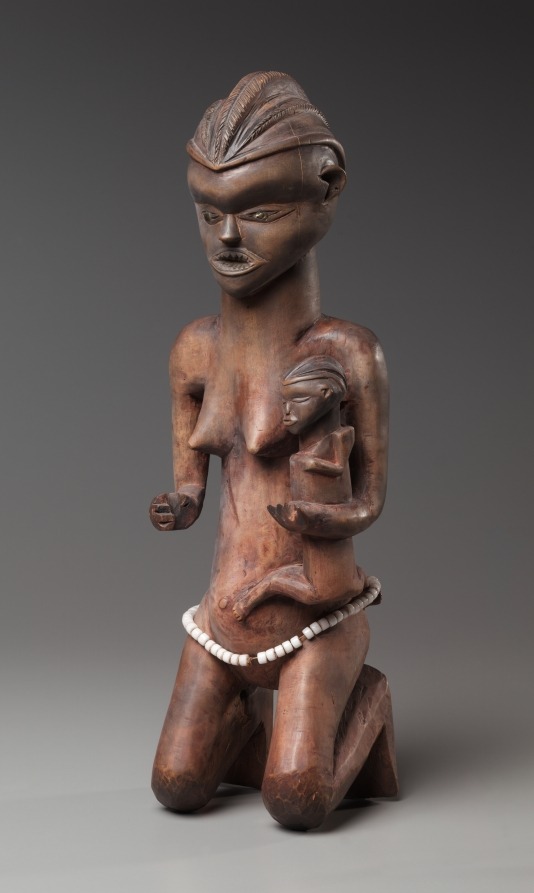
Mother-and-Child Figure, late 1800s-early 1900s, Cleveland Museum of Art: African Art
Wearing an elaborate lobed headdress and a beaded waistbelt, and having filed teeth and red-powdered skin, this maternity figure seems to have once carried an ax and a cup, wooden imitations of the two most important chiefly attributes. Perhaps together with a male counterpart, it was secretly kept inside the ritual house, serving as a guardian of the chief’s treasure. Its style places it in the westernmost corner of Pendeland, between the Lutshima and Kwilu rivers.
Size: Overall: 53.4 x 13.1 x 14.6 cm (21 x 5 3/16 x 5 3/4 in.)
Medium: wood, metal, beads
https://clevelandart.org/art/1931.426
46 notes
·
View notes
Text
Missionary died thinking he was a failure
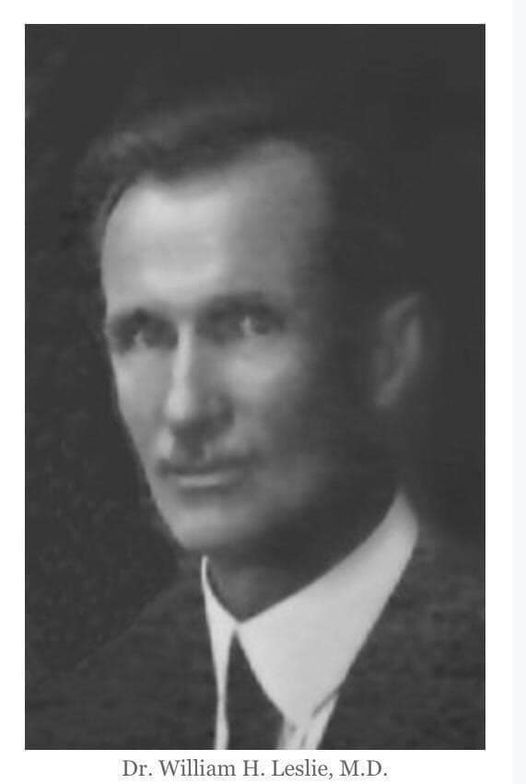
In 1912, medical missionary Dr. William Leslie (1868-1935) went to live and minister to tribal people in a remote corner of the Democratic Republic of the Congo. After 17 years he returned to the U.S. a discouraged man – believing he failed to make an impact for Christ. He died nine years after his return.
But in 2010, a team led by Eric Ramsey with Tom Cox World Ministries made a shocking and sensational discovery. They found a network of reproducing churches hidden like glittering diamonds in the dense jungle across the Kwilu River from Vanga, where Dr. Leslie was stationed.
Based on his previous research, Ramsey thought the Yansi in this remote area might have some exposure to the name of Jesus, but no real understanding of who He is. They were unprepared for their remarkable find.
“When we got in there, we found a network of reproducing churches throughout the jungle,” Ramsey reports. “Each village had its own gospel choir, although they wouldn’t call it that,” he notes. “They wrote their own songs and would have sing-offs from village to village.”
They found a church in each of the eight villages they visited scattered across 34 miles. Ramsey and his team even found a 1000-seat stone “cathedral” in one of the villages. He learned that this church got so crowded in the 1980s – with many walking miles to attend — that a church planting movement began in the surrounding villages.
“There is no Bible in the Yansi language,” Ramsey says. “They used a French Bible, so those who taught had to be fluent in French.”
Apparently, Dr. Leslie crossed the Kwilu River once a year from Vanga and spent a month traveling through the jungle, carried by servants in a sedan chair.
“He would teach the Bible, taught the tribal children how to read and write, talked about the importance of education, and told Bible stories,” Ramsey notes. Dr. Leslie started the first organized educational system in these villages, Ramsey learned.
It took some digging for Ramsey to uncover Leslie’s identity. “The tribal people only knew him by one name and I didn’t know if that was a first or last name. They knew he was a Baptist and he was based in that one city and they knew the years.”
When Ramsey returned home he did some additional investigation and discovered Dr. Leslie was affiliated with the American Baptist Missionary Union. The American Baptist Missionary Union was founded in 1814 by Adoniram Judson, who led a pioneering work in Burma. Born in Ontario, Canada, William H. Leslie followed his intended profession as a pharmacist until his conversion in 1888. He moved to the Chicago area, where God began to grip his heart with the desire to become a medical missionary.
Dr. Leslie initiated his Congo service in 1893 at Banza-Manteke. Two years later he developed a serious illness. A young missionary named Clara Hill took care of him until he recovered. Their budding friendship ripened into love and a marriage proposal. They were wed in 1896.
In 1905 William and Clara pioneered a work in Cuilo, Anglola, where they overcame a hurricane that struck the night before one of their children was born, and more mundane obstacles like charging buffaloes and armies of ants.
Seven years later they cleared enough of the leopard-infested jungle along the Kwilu River at Vanga for a new mission station perched on a small plateau. Some of the villages surrounding Vanga were still practicing cannibalism at that time.
They spent 17 years at Vanga, but their service ended on a rocky note. “Dr. Leslie had a relational falling out with some of the tribal leaders and was asked not to come back,” Ramsey says. “They reconciled later; there were apologies and forgiveness, but it didn’t end like he hoped.”
Dr. Leslie died thinking he was a failure; 84 years later thriving churches were found hidden in the jungle. “His goal was to spread Christianity. He felt like he was there for 17 years and he never really made a big impact, but the legacy he left is huge.”
12 notes
·
View notes
Photo

♀ My Yoruba Ancestry [YA = YAKA] of Prosperous Ghanian African [GA = ROMAN] American Indian Wealth that Magically Energized [ME = U.S. Michael Harrell = TUT = JAH] My MOST HIGH [MH = JAH] KINGDOMS that BEE So GOLDEN [DIVINE] 2 ALL My PREHISTORIC Nubian Earth Indians that BEE So Multi EThnically [E.T.] Black accordin’ 2 Our MOST HIGH [MH = JAH] MAMA of AFTERLIFE [MA] ATLANTIS… now JAH Witness Me [ME = U.S. Michael Harrell = TUT = JAH] as I SPIRITUALLY TESTIFY OUT LOUD ♀
#U.S. Michael Harrell#U.S. King TUT of Celestial Atlantis [CA]#My Yoruba Ancestry [YA = YAKA] of HIGHLY Elaborate Congo Afrikkan [CA] American Rituals#My HIGHLY Artistic Yaka Ancestors [YA = BAYAKA] of Kwango + Kwilu River Indian Bloodlines#My Ancient [MA] Yoruba Ancestry [YA = YAKA] of HIGHLY Elaborate Congo Afrikkan [CA] American Ritual Magick#My Yoruba Ancestry [YA = YAKA] of Prosperous Ghanian African [GA = ROMAN] American Indians#PREHISTORIC Nubian Earth Indians that BEE So Multi EThnically [E.T.] Black#MU of Lost Atlantis [L.A.]#Our Prehistoric Nubian Orthographies of Khemetic [NOK] Ebonics
1 note
·
View note
Text
#ActualiteCD. | aquatic species have left Kasai since the pollution - Desk Nature
#ActualiteCD. | aquatic species have left Kasai since the pollution – Desk Nature
Fish and other aquatic species have left the Kasai River in Kwilu province following the destruction of their biotope by toxic substances recently poured into the river from Angola by an industry, ACTUALITE.CD has learned from official sources.
The head of the geographic information system service office of the provincial Ministry of the Environment, Malonga KULIBALI, invites the central…

View On WordPress
0 notes
Text
20 Questions
@buttsonthebeach tagged me in the getting to know you meme, but since I did that one recently I took the liberty of breaking the rules and finding another tag meme to answer instead. >:Dc
1. One thing you would change in your personality?
The constant undercurrent of social anxiety that renders me completely unable to speak coherently at the worst possible moments. I would love to have steady employment, social anxiety. Please stop cockblocking my job status. :^)
2. What is your DA rare pair?
MARIAN HAWKE AND RALEIGH SAMSON
GO RAID MY AO3, MY KIRKWALL TRASH HEAPS ARE WAITING
Sweetest Downfall
Arms Around the Past
3. A song that made you cry?
Passage by Vienna Teng. I've never had a song get me completely unglued on the last six words before this.
4. The best movie ever?
Love, Actually.
Fight me.
5. Food you will never eat?
C I L A N T R O >:(
6. Your celebrity crush?
Felicia Day. Mark of the Assassin DESTROYED me. 😅
7. Your favorite DA location and why?
Vigil's Keep. Because like. You're the head dumpster fire, in charge of recruiting more dumpster fires, and also you're apparently running an Arling that you never asked for and you have to deal with all these shitty nobles all the time but YOUR DUMPSTER FIRES are all right there beside you and you have the best papa dumpster fire ever who kicks nobles out of your dumpster fire house when you're tired of partying and basically it's this tiny fucked up little family and you all stumble down to breakfast in the morning in various states of hung over except for that one dwarf guy who's probably still drunk, you eat your eggs and toast in cranky silence, and then you go be big goddamn heroes.
....I really loved Awakening ok. Fite me.
8. You’re a night or a morning person?
I'm like a "night but the part of night where it's technically morning right up til morning" kind of person.
9. You have any tattoos?
Yus.
Nobody sigil from Kingdom Hearts wrapped in a treble clef between my shoulder blades.
A design of Helios on my left upper arm with "Unbowed, Unbent, Unbroken" underneath it because House Martell prideeee.
The Arabic word for "cat" on my left forearm, drawn to look like a cat.
I'm saving up for a griffon tattoo and maybe a stylized one of "can I get you a ladder so you can get off my back?" :3
10. How many languages you speak?
Fluent in English. Can understand Korean fairly well, but can't speak it quite as easily. Basic fluency in Italian. I can read it much better that I can speak it.
11. Where would you most like to visit?
The mountains in South Korea. I was born there and I've only ever been back to Seoul and a village on the outskirts where my grandparents lived. I want to spend like a week or so out there under the stars. ❤️
12. What’s the best book you’ve read?
The Poisonwood Bible.
So I was forced to read this in high school. And I went to a Baptist high school, so of course when I saw this summary of it I immediately went "oh fuck no."
"The Poisonwood Bible, by Barbara Kingsolver, is a bestselling novel about a missionary family, the Prices, who in 1959 move from the U.S. state of Georgia to the village of Kilanga in the Belgian Congo, close to the Kwilu River."
Like. I was FULLY prepared to grit my teeth and spark notes another goddamn glorified colonialism story.
And then I read the damn thing.
And y'all this book is FUCKED UP. That missionary family? It's told from the POV of all of the daughters as they watch their father get more and more fanatical and abusive, as they struggle with culture shock, NONE of them wanted to be here, the majority of them slowly start to lose their faith and abandon their religion.
One of the girls is very clearly neurodivergent, but she's not really written as a character you're supposed to feel sorry for, and she's a total badass.
It has its problematic elements, but I think the fact that it's now seared indelibly into my brain is because I was 100% expecting a fucked up pro missionary story and ended up finding a story of the shit that happens to everyone else in the periphery of said pro missionary stories.
Was incredibly surprised to have read this in my AP Lit class at a Baptist high school, but goddamn, it shook me.
13. Who is your favourite BioWare character?
A N D E R S
Anders is my boy. I will ride or die for Anders. Anders was right. Fuck the Chantry. F I T E M E.
Bonus: fine Dwarven crafts, direct from Orzammar
14. Who’s your least preferred BioWare character?
Going to stick to Dragon Age because I'm too tired to rummage through my brain for other fandoms. And there's so many people I hate in Mass Effect. Hah.
Anyway. Livius Erimond kind of grinded my gears a lot, so much so that in my first mage playthrough I pissed off a ton of people and made him Tranquil. Like. My entire inner circle disapproved, it was fucking amazing. I'll never be able to make myself do it again because I felt so dirty after that I literally had to pause the game and take a shower, but man. Erimond is really good at pressing buttons.
15. What’s your favourite game?
Dragon Age Inquisition and Mass Effect 3. And Neverwinter Nights: Hordes of the Underdark. Valen Shadowbreath was my first bioware love.
16. What’s your spirit animal patronus?
According to Pottermore it's a dragonfly but I'm pretty sure it's actually a cat.
Going with patronus instead of spirit animal because I've been asked to avoid appropriating that term as someone who is not of Native ancestry, and so I shall. Respect indigenous cultures. ✌️❤️
17. Cake or ice cream?
Fine Dwarven cakes, direct from Orzammar. Preferably almond or Chantilly. :D
18. Dogs or cats?
🐈 Kitties 🐈
19. What was your favourite DA romance?
3 Way Tie (although this could change since I haven't done all of them myself.)
Anders - because his whole arc is just so FUCK THE CHANTRY and he's such a Good Person who is Struggling and at the end of the day he's a soft feathery boy who loves you and cares about making people not hurt anymore and also is into some wild shit in bed and also loves cats. Let's be mentally ill cuddly softs together, Anders, I will give you my everything always, my soft feathery mage boy. ❤️❤️❤️❤️❤️
Leliana - soft but stabby song princess becomes the pope and her devoted girlfriend wife swoons quietly through all of it.
Cullen - weirdly enough, I did not expect to enjoy this romance as much as I did. I kind of hated him in the first two games, like when I ran into him in 2 I still hadn't forgiven him for the "KILL ALL THE MAGES" outburst and was just like. "Ugh it's this motherfucker." And then I saw him again in Inquisition and was like WHAT THE FUCK IS THIS SHITHEAD DOING HERE? HE'S FIRED. FIRE HIM, CASSANDRA.
But then Cassandra never reciprocated my affections, Blackwall yelled at me on the battlements about propriety and we're at war so I dumped him, and then Vivienne turned me down and I was like FINE FUCK ALL Y'ALL I'M GONNA SMOOCH CULLEN OUT OF SPITE.
And then he's all like. "I went through some shit. I said some really fucked up stuff. Also I'm trying to get clean and it's literally killing me but I don't want anything to do with that old life anymore." And the chess scene, and then me getting really personally enraged at all the Orlesians copping nonconsensual feels at Halamshiral and then I woke up one day and was like wow OK this dude's alright, he's even kind of cute, I guess I can-
"marry me?" "OKAY YES."
*shrug* I'm weak.
20. Do you prefer sunshine or are you a winter person?
Sunshine in winter, ideally, but if I have to choose between one or the other, winter.
Anyway. I broke rules, oops. Gonna tag @sasshole-for-rent @suzumicchi @joufancyhuh @laraslandlockedblues @becauseanders @inner-muse @ladymdc @agentkatie @kawakaeguri @a-shakespearean-in-paris @ekoorb03 @lyrium-lovesong @5ftgarden
17 notes
·
View notes
Photo

Kwilu Sunrise I painted this using a photo I took overlooking the Kwilu River at sunrise while visiting Vanga, DRC in 2002.
0 notes
Text
콩고 민주 공화국
New Post has been published on http://dramashot.me/%ec%bd%a9%ea%b3%a0-%eb%af%bc%ec%a3%bc-%ea%b3%b5%ed%99%94%ea%b5%ad/
콩고 민주 공화국
콩고 민주 공화국(프랑스어: République démocratique du Congo, 콩고어: Repubilika ya Kongo Demokratiki, 링갈라어: Republiki ya Kɔ́ngɔ Demokratiki, 스와힐리어: Jamhuri ya Kidemokrasia ya Kongo, 루바어: Ditunga dia Kongu wa Mungalaata, 영어: Democratic Republic of the Congo, 문화어: 민주 꽁고)은 아프리카에 있는 공화국이며 수도는 킨샤사이다. 아프리카에서 3번째로 국토 면적이 큰 나라로 북쪽으로 중앙아프리카 공화국·수단, 동쪽으로 동(東)아프리카 대지구대(大地溝帶)의 호수를 사이에 두고 우간다·르완다·부룬디·탄자니아, 남쪽으로 고원지대를 사이에 두고 잠비아·앙골라, 서쪽으로 콩고와 국경을 접한다. 줄여서 DRC, RDC, DR콩고, 콩고, 콩고-킨샤사(Congo-Kinshasa)라고도 부른다.
République Démocratique du Congo
국기 국장
표어: Justice, Paix, Travail
(프랑스어: 정의, 평화, 노동)
국가: 콩고인이여, 일어나라!
(프랑스어: Debout Congolais)
수도 킨샤사
4°24′S, 15°24′E 공용어 프랑스어
(국민 언어는 콩고어, 링갈라어, 스와힐리어, 루바어) 정부 형태
대통령
총리
대통령제
조제프 카빌라
아돌프 무지토 독립
• 독립 벨기에로부터 독립
1960년 6월 30일 면적
• 전체
• 내수면 비율
2,344,858km² (12위)
3.3% 인구
• 2007년 어림
• 1984년 조사
• 인구 밀도
63,655,000명 (20위)
29,916,800명
25명/km² (179위) GDP (PPP)
• 전체
• 일인당 2005년 어림값
$464.91억 (78위)
$774 (174위) HDI
• 2006년 조사 0.361 (177위) 통화 프랑 (ISO 4217:CDF)
시간대
• 여름 시간 CET, EET (UTC+1, +2)
없음 ISO 3166-1 180 ISO 3166-1 alpha-2 CD ISO 3166-1 alpha-3 COD 인터넷 도메인 .cd 국제 전화 +243 1971년에서 1997년까지는 “자이르”라고 불렀다.
콩고 공화국과는 전혀 다른 나라이다.
국명
국명은 ‘사냥꾼’이라는 뜻으로, 콩고강(江) 유역에 사는 바콩고(Bakongo)라는 부족 이름에서 딴 것이다.
독립 당시에는 콩고 공화국이라고 하였으나 1964년에 콩고 민주 공화국으로, 1971년에 자이르공화국으로 변경되었고, 1997년 5월에 지금의 국명으로 고쳤다.
역사
16세기에 지금의 샤바주(州) 지역에 최초의 왕국인 루바 왕국이 세워졌고 서북쪽에는 작은 추장령의 연합체인 쿠바(Kuba) 왕국이 있었다. 루바 왕국은 16세기에 콩골로라는 이름의 한 무사가 카탕가 지역�� 작은 추장령(酋長領)들을 정복하여 고도로 중앙집권적인 정부를 수립한 데서 비롯되었다.
↑식민지 시대 이전에 화폐로 사용된 카탕가 크로스(Katanga Cross).
1878년 벨기에 국왕 레오폴 1세는 콩고강(지금의 자이르강) 유역을 탐험하고 돌아온 영국계 미국인 탐험가 헨리 모턴 스탠리(Henry Morton Stanley) 경을 초빙하여 그에게 콩고강 유역에 기지를 설치하도록 명령한 다음 ‘국제콩고협회’를 조직하여 이곳을 통치하였다. 1884년 미국이 이 체제를 승인한 데 이어 이듬해 개최된 베를린 회의(콩고분지조약 조인)에서 이곳의 지배권을 얻어낸 레오폴드 2세는 ‘콩고자유국’으로 이름을 고친 뒤 자기의 사유영지(私有領地)로 만들었다.
그러나 자유국이라는 이름과는 달리 그 통치방법은 주민들에게 상아·고무·야자유(油) 등의 채취량을 강제 할당하는 약탈방식이었으며, 할당량을 채우지 못한 주민들은 군대에 의하여 형벌을 받았다. 이러한 ‘레오폴 방식’을 두고 국제적으로 비난의 소리가 높아지자 1908년 레오폴 2세는 사유영지 형식에서 벨기에정부의 식민지인 ‘벨기에령 콩고’로 바꾸었다.
그러나 작은 나라인 벨기에로서는 본국의 77배나 되는 광대한 영토를 가진 데다 인구마저 희박한 이곳을 개발할 능력이 없었다. 더욱이 제1차 세계대전 중 독일군의 공격으로 황폐해졌기 때문에 1920년대부터 영국·미국 자본을 들여오고 새로 위임통치령(委任統治領)이 된 르완다·부룬디의 노동력이 유입됨으로써 겨우 농림업이나 광업의 자본주의적 개발에 착수할 수 있게 되었다.
↑벨기에령 콩고에서의 벨기에 병사들(1918).
1921년에는 유럽 문명과 그리스도교 선교사들을 배척하는 예언적 종교 운동인 킴방구주의(Kimbanguism)가 태동해 주민들을 결집시켰다. 민족주의는 뒤늦게 ���타나 서서히 성장해갔다. 백인이든 흑인이든 투표권을 갖게 된 것도 1957년의 일이지만, 일단 민족주의 바람이 일자 민족주의는 극적으로 성장했다.
1926년부터는 노동자의 정착을 꾀하는 복지후생정책이 도입되고 강제적인 가톨릭 신봉과 함께 생산성 향상을 위한 교육이 실시되었다. 또한 자본주의적 기업에 고용된 아프리카인들은 부족사회의 주민과는 비할 수 없는 물질적 우대를 받았다.
광대한 지역 내에 점(點)과 선(線)으로 연결할 수 있는 지역을 확보하고 개발도 진전되었으나 부족간의 대립과 주민들의 반(反)벨기에 운동이 그치지 않았기 때문에 치안유지와 영내 통일은 식민지군(植民地軍)에 의지할 수밖에 없었다. 따라서 아프리카인·백인을 가리지 않고 모든 정치활동이 금지되었다. 제2차 세계대전 후 부근의 영국·프랑스 식민지에서 아프리카인의 정치적 참여가 실현되고 자치(自治)를 거쳐 독립을 획득하는 과정은 벨기에령 콩고인들에게도 강력한 인상을 심어주었으며, 1959년 1월 그들은 반(反)벨기에 폭동을 일으켰다.
사태가 이렇게 되자 벨기에는 그들의 독립을 고려하지 않을 수 없게 되었고, 1960년 6월 30일 최초의 총선거를 통해 수립된 아프리카인 정부에 독립을 부여하였다. 그러나 아무런 준비기간도 없었고 정치적 훈련마저 부족하였으므로 독립 직후 3년 동안 콩고동란(動亂)이 일어났다. 그 사이에 파트리스 루뭄바(Patrice Lumumba) 총리, 모부투 세세세코(Mobutu Sese Seko) 군사정권, 모이스 카펜다 촘베(Moïse Kapenda Tshombe) 총리로 이어지는 불안정한 정권교체가 잇달았으며, 1965년 11월 모부투 세세세코가 다시 쿠데타에 성공하여 정권을 장악하였다.
↑파트리스 루뭄바.
콩고 민주 공화국은 1965년 11월 이후 모부투 세세세코가 국가원수의 자리에 오르면서 1967년 5월에는 혁명인민운동(MPR)의 1당제 국가인 콩고 민주 공화국이 되었으며, 1970년 11월에 실시된 선거에서 모부투 세세 세코가 100%의 지지를 얻어 대통령에 당선되었다. 모부투 세세 세코 대통령은 국내에서 벨기에의 잔재를 말소하기 위하여 수도 레오폴드빌의 이름을 킨샤사로 고치는 등 주요도시의 명칭을 바꾸고 1971년에는 국명과 콩고강(江)의 명칭을 자이르 및 자이르강으로 개칭하였다. 이와 함께 국기(國旗)도 바꾸었고 그밖에 세례명을 폐지하여 공무원을 비롯한 국민들에게 이를 철저히 지키도록 명령하였다.
↑자이르 공화국의 화폐.
모부투 세세세코 대통령은 국가건설에 사회주의적 정책을 도입하여 주요기업을 국유화하는 한편 외교정책에서도 공산권에 접근하고 1974년에는 이스라엘과 외교관계를 단절하였다. 1974년 8월에는 헌법을 개정하고 MPR 당수가 자동적으로 대통령이 되게 하였다. 그러나 1975년 인접국 앙골라 독립운동단체인 좌우파(左右派) 사이에 내란이 일어나자 모부투 세세 세코 대통령은 미국과 함께 우파를 지원하였다. 그 때문에 1977년 3월 모부투정권에 반대하는 앙골라 무장세력의 침입을 받기도 하였다. 이는 프랑스·벨기에·모로코의 군사개입으로 제압되기는 하였으나 1978년 이와 비슷한 침입사건이 다시 일어났으며, 앙골라와의 사이에 긴장이 고조되었다. 이에 같은해 7월 두 나라 대통령은 국경선 존중, 반정부 게릴라의 상호 배제(排除) 등에 관한 협정을 체결하였다.
1978년 5월에는 앙골라·쿠바군이 모이세 촘베의 카탕카군을 지원하여 반란을 일으켰으나 프랑스·벨기에·모로코의 파병과 미국의 간접지원으로 위기를 모면하였다. 내란이 끝난 뒤 쿠바·동유럽권과의 관계를 정상화시키고, 1981년 5월에는 이스라엘과도 외교를 재개하였다. 그러나 이에 대해 아랍 여러 나라는 단교할 것을 권하였다. 그 후 1997년 5월 로랑 카빌라(Laurent Kabila)가 이끄는 반군세력에 의해 모부투 세세세코 대통령이 축출되면서 국명을 콩고 민주 공화국으로 개칭하고 국기도 바꾸었다.
1998년 8월에 우간다·르완다 등이 지원하는 반정부세력이 무장 봉기하고, 짐바브웨·앙골라·나미비아 등은 카빌라 정권 옹호를 위해 콩고 민주 공화국에 군사를 파견함으로써 내전이 발발하였고 이는 7개국이 관여한 국제분쟁(콩고 전쟁)으로 발전하였다. 1999년 8월 말 평화합의가 성립되었으나 불안정한 정세가 계속되었다. 2001년 1월 로랑 카빌라 대통령이 살해되어 같은 달에 아들인 조제프 카빌라(Joseph Kabila)가 대통령에 취임하여 개방노선을 취하고 있다.
↑콩고 전쟁때 콩고 민주 공화국과 르완다의 경계선에서 대기하는 피난민들(2001).
지리
↑콩고 강(The Congo River).
콩고 민주 공화국은 국토의 대부분이 아프리카 탁상지 상의 콩고분지 안에 위치하며 중앙에서 약간 북쪽으로 치우친 지점을 적도(赤道)가 횡단하고 있다. 동쪽은 동(東)아프리카 대지구대(大地溝帶)의 호수를 국경으로 하고, 남쪽은 고원지대를 사이에 두고 잠비아, 앙골라와의 국경이 펼쳐진다. 지구대의 높은 산지와 고원지대로부터 형성된 수많은 지류가 북류하다가 콩고와의 국경선 상에 합류하여 이루어진 자이르강(콩고강)과 그 지류인 우방기강이 대서양으로 흘러들어 간다. 콩고강과 지류에 의하여 이루어진 콩고분지(중앙분지)가 전국토의 3/5을 차지하며, 국토의 동·남쪽으로는 고원지대이다.
콩고강은 길이 6,400㎞의 세계적으로 큰 강으로 수력발전 잠재력이 큰 지대(세계 총 잠재력의 1/8, 아프리카의 1/2)로써 유역면적(3,457,000㎢)은 아마존강에 이어 세계 2위이다. 동쪽으로 부룬디, 탄자니아와 국경을 이루는 탕가니카 호수는 세계적 규모의 큰 호수로써 면적은 32,900㎢, 깊이는1,400m이다.
적도를 중심으로 하여 북위 5도에서 남위 13도에 걸쳐있으므로 전체 면적의 절반 이상이 열대우림으로 덮여 있고, 북쪽 끝 지역은 초목이 듬성듬성 나 있는 곳이 많은 사바나지대이며, 동쪽 및 남쪽 끝 지역도 사바나지대가 나타난다. 대개 겨울에는 북부, 여름에는 남부가 건조하다. 전국의 연평균 강수량은 1,070mm 정도이고, 열대우림 지대의 연평균온도는 30℃, 사바나지대는 25℃이다. 전체 국토 면적 중에서 경작 가능지는 2.86%, 농경지는 0.47%, 산림 및 기타는 96.67%(2005년)이다.
↑콩고 민주 공화국의 위성 사진.
2002년 1월 17일, 이라곤고 화산(Mount Nyiragongo)이 폭발하여 피해를 입었다. 용암이 고마 시(Goma)로 흘러들어 45명이 죽었고 12만 명 이상이 집을 잃었다. 40만 명 이상의 사람들이 대피하기도 했다. 용암이 키부 호로 흘러들면서 수많은 물고기가 죽기도 했다. 공항의 경우 공항 전체를 용암이 뒤덮지는 못했지만 활주로를 비롯해 수많은 비행기가 피해를 입었다. 폭발 6개월 이후 니아무라지라 화산(Mount Nyamuragira)이 터지고 2006년 한 번 더 터졌다. 두 화산 모두 여전히 활화산이다.
↑니아무라지라 화산(Mount Nyamuragira).
정치
2006년 2월 18일 제정된 헌법에 따르면 콩고민주공화국은 대통령중심제공화국이다. 지난 6년 간의 내전을 극복하고 2002~2003년에 걸쳐 체결된 평화협정에 따라 과도정부가 수립되었다. 2006년 10월 임기 5년의 연임가능한 대통령으로 조제프 카빌라 (Joseph Kabila)가 재선에 성공하였다. 국무총리와 행정부의 장은 대통령이 임명한다.
의회는 양원제로 운영되며 상원은 108명으로 임기는 5년, 지방의회에서 선출된다. 국민의회라 불리는 하원은 500명으로 임기 5년이다. 2006년 7월 30일 총선 결과 국민의회의 정당별 의석 분포는 재건과 민주를 위한 인민정당(PPRD) 111석, 콩고자유운동(MLC) 64석, 통합콩고당(PALU) 34석, 재생을 위한 사회운동(MSR) 27석, 재생을 위한 운동(FR) 26석, 민주를 위한 콩고랠리(RCD) 15석, 무소속 63석, 기타 160석(10석 이하의 의사를 획득한 63개 정당) 등이다. 상원의 정당별 의석 분포를 보면 재건과 민주를 위한 인민정당(PPRD) 22석, 콩고자유운동(MLC) 14석, 재생을 위한 운동(FR) 7석, 민주를 위한 콩고랠리(RCD) 7석, 기독교민주당(PDC) 6석, 기독민주대회(CDC) 3석, 재생을 위한 사회운동(MSR) 3석, 통합콩고당(PALU) 2석, 무소속 26석, 기타 18석(1석을 획득한 소수정당에 의한 의석) 등이다.
법원은 3심제로 운영되며 헌법재판소가 있다.
행정 구역
콩고 민주 공화국의 행정구역은 2009년 부터 10개의 주(province)와 1개의 시(ville)로 구성되었다.
↑킨샤사.
-2009년 이전의 행정 구역
주 주도 1. 킨샤사(Kinshasa) 킨샤사(Kinshasa) 2. 중앙 콩고(Kongo central) 마타디(Matadi) 3. 크왕고(Kwango) 켄게(Kenge) 4. 크윌루(Kwilu) 키크위트(Kikwit) 5. 마이 은돔베(Mai-Ndombe) 이논고Inongo 6. 카사이(Kasaï) 루에보(Luebo) 7. 루루아(Lulua) 카난가(Kananga) 8. 카사이 오리앙탈(Kasaï oriental)
음부지마이
(Mbuji-Mayi)
9. 로마미(Lomami) 카빈다(Kabinda) 10. 산쿠루(Sankuru) 로디자(Lodja) 11. 마니에마(Maniema) 킨두(Kindu) 12. 남 키부(Sud-Kivu) 부카부(Bukavu) 13. 북 키부(Nord-Kivu) 고마(Goma)
주 주도 14. 이투리(Ituri) 부니아(Bunia) 15.
오트 우엘레
(Haut-Uele)
이시로(Isiro) 16. 트쇼포(Tshopo) 키상가니(Kisangani) 17.
바스 우엘레
(Bas-Uele)
부타(Buta) 18.
북 우방기
(Nord-Ubangi)
그바도리테(Gbadolite) 19. 몽갈라(Mongala) 리살라(Lisala) 20.
남 우방기
(Sud-Ubangi)
게메나(Gemena) 21. 에콰테우르(Équateur) 음반다카(Mbandaka) 22. 트슈아파(Tshuapa) 보엔데(Boende) 23. 탕가니카(Tanganyika) 칼레미(Kalemie) 24.
오트 로아미
(Haut-Lomami)
카미나(Kamina) 25. 루알라(Lualaba) 콜웨지(Kolwezi) 26.
오트 카탕가
(Haut-Katanga)
루붐바시(Lubumbashi)
-2009년에 정해진 행정 구역
반둔두(Bandundu)
바스-콩고(Bas-Congo)
에쿼추어(Équateur)
카사이옥시당탈(Kasai-Occidental)
카사이오리앙탈(Kasai-Oriental)
카탕가(Katanga)
킨샤사(Kinshasa)
마니에마(Maniema)
북 키부(Nord-Kivu)
오리앙탈레(Orientale)
남 키부(Sud-Kivu)
경제
산업별 GDP 구성 비율은 농업 55%, 광공업 11%, 서비스업 34%(2000년 추산)이다. 농업에 전적으로 의존하며 광산자원이 풍부하다. 특히 광물자원은 매우 풍부하여 공업용 다이아몬드는 세계 제1의 생산량을 자랑한다. 이밖에 금·은·우라늄광·구리·코발트·주석·아연·망간·탄탈·카드뮴·라듐·철·석탄 등이 상당량 채굴된다. 광물자원은 남동쪽에 있는 샤바주(州)에 가장 많이 매장되어 있다. 그밖에 대서양에서는 광범위한 석유자원이 개발되고 있다. 그러나 이러한 자원 개발이 서방 자본에 의지하여 개발되고 있기 때문에 경제 발전에 큰 도움이 되지 못한다. 농산물은 유성(油性)야자·고무·커피·코코아 등이 주산물이다.
독립 후 수년 동안 혼란이 계속되었기 때문에 모든 산업 활동이 크게 위축되었다. 1966년부터 벨기에 등의 자본으로 운영되는 기업을 국유화하고 1977년에는 통화개혁을 단행, 콩고 프랑을 폐지하고 자이르화(貨)를 신설하는 등 경제개발의 기반을 다���다. 광업 및 투자에 관한 새 법령 제정으로 광업투자가 증가하고 있어 2004년 말부터는 회복세가 현저해졌으며 IMF로부터의 원조자금이 유입되기 시작하면서 경제회복이 빠르게 진행되고 있다.
또한 자이르강(콩고강) 하류의 잉가댐 건설을 계획하여 1972년에 제1기 공사를 끝낸데 이어 1977년 제2기 공사를 완료함으로써 1,300MW의 수력발전이 가능하게 되었다. 따라서 전력은 충분히 확보하였으나 공업화의 진전은 아직도 미약하다. 수출품 중에서는 광산물이 가장 큰 비율을 차지하고 그 중 구리가 가장 많았으며 코발트, 다이아몬드가 그 뒤를 잇고 있다. 농산물로는 커피가 큰 비중을 차지하고 있다. 주요 수출상대국의 비중은 벨기에 24.1%, 중국 22.3%, 브라질 12.8%, 미국 10%, 핀란드 7.4%, 프랑스 7%(2006년)이며, 수입상대국의 비중은 남아프리카 공화국 17.6%, 벨기에 10.9%, 짐바브웨 8%, 프랑스 7.3%, 잠비아 6.8%, 케냐 6.8%, 미국 4.4%, 코트디부아르 4.4%(2006년) 등이다.
↑콩고 민주 공화국의 GDP 성장률.
-교통
교통은 자이르강 본·지류를 합해 항행 가능한 부분 약 1만 5000km를 중심으로 하고, 화물수송의 대동맥인 벵겔라철도를 비롯한 철도(길이 5,138km;1995)와 길이 14만 5,000km의 도로(포장 도로는 2,500km)가 있다. 킨샤사국제공항을 중심으로 약 3만 5400km에 달하는 국내항로도 개발되어 있다. 유일한 항구는 자이르강 하구에서 160km 떨어진 마타디이며, 탕가니카호(湖)의 칼레미항(港)도 동(東)아프리카 여러 나라와의 문호로써 중요한 구실을 한다.
↑루붐바시에서 킨두(Kindu)를 잇는 철도에서 달리는 열차.
주민
인구 1000명당 출생율은 43명, 사망율은 11.88명으로 전형적인 다산소사형이다. 유아사망율은 83.11명, 기대수명은 53.98세로 후천성 면역 결핍증에 감염된 비율이 4.2%(세계 26위)이다. 백인을 제외하고 민족적으로 크게 나누면 반투어족(총 인구의 2/3)·수단어(서아프리카)계·햄어계·피그미어계로 분류할 수 있다. 부족별로는 약 200개에 이르나 대부분이 반투어족에 속한다.
↑콩고 민주 공화국의 여성.
↑푸푸 지방의 여성.
언어
넓은 영토 때문에 정확히 셀 수 없을 정도로 많은 언어와 그에 딸린 방언이 혼재하고 있다. 2005년 12월 18일, 19일에 걸친 국민투표 결과 61.97%가 참가하여 84.31%가 찬성, 2006년 2월 4일 대법원에 의해 확정된 헌법안의 규정을 보면 1부 1장 1절 1항에 “공용어는 프랑스어이며, 국민 언어로는 콩고어, 링갈라어, 스와힐리어, 루바어이다.”고 규정하고 있다.
1998년, 쿠데타로 모부투 세세세코를 쫓아낸 로랑 데지레 카빌라 대통령은 영어를 공화국의 공용어로 추가시키는 헌법안을 마련하였지만 실행에 옮기지는 못했다..
국제프랑스어사용국기구(OIF), 프랑코포니가 2005년 발간한 자료에 의하면, 인구의 9%가 프랑스어를 상용하고, 34%가 경우에 따라서 사용한다고 하여 43%가 프랑스어를 사용한다고 그 추정치를 밝히고 있다. 군대 공용어인 링갈라어는 수도 킨샤사에서 널리 쓰이고 있다.
↑콩고 민주 공화국의 언어.
종교
종교는 가톨릭이 50%, 그리스도교가 20%, 토착 그리스도교인 킴방구교가 10%, 이슬람교가 10%, 기타 토착신앙이 10%를 차지한다. 문맹율은 32.8%(2001년 추산)이다.
교육
의무 교육 기간은 6년이고 취학률은 대체로 낮은 편으로 초등교육기관이 79%, 중등교육기관이 23%를 차지하고 있다. 고등교육기관으로는 자이르국립대학교 등이 있다. 정부지출 중 교육비의 비중이 1972년 15.1%에서 1995년 0.8%로 낮아졌고 초등교육 이수율이 계속 감소하여 미래의 노동생산성 및 발전전망이 우려된다.
↑콩고 민주 공화국의 교실.
복지
국민들은 극심한 영양실조에 시달리고 있으며, 후천성면역결핍증(AIDS)·말라리아·위장염·결핵·나병·아프리카수면병·주혈흡충증(住血吸蟲症) 같은 중병이 흔히 발생한다. 영아사망률은 높고 평균수명은 남자 52세, 여자 56세로 낮다. 병원·진료소가 인구에 비해 모자라며, 빈약한 위생시설과 시골 지역의 의사 부족으로 보건 문제가 악화되고 있다.
공공보건센터는 내전과 정치불안으로 제 기능을 발휘하지 못하고 있다. 의료장비가 없는 지역이 다수이고 예방접종 중단으로 인해 홍역이 만연하고 있으며 영양실조도 심각한 수준이다.
군사
군사비 지출은 GDP의 2.5% (2006년)이며 의무병역제를 운영한다.
언론
대중매체는 정부에 의해 엄격히 통제되며, 정부를 비판하는 언론인은 투옥된다. 국영 유선전화회사가 파산 직전이라 휴대전화 가입자가 늘어 50만명에 이른다. 수도 킨샤사에서 정기적으로 발행되는 신문 15개와 민영방송국(라디오 10개, TV 8개) 다수가 있다.
사회
콩고 민주 공화국은 아직도 부족주의적 유대관계가 매우 강하고 인구의 80%가 도시나 교통로 연변에 살고 있다. 독립 후 킨샤사는 현저하게 팽창하였으며 도시 주민은 부족적 유대관계를 떨쳐버리고 근대적 조직체를 구성해가고 있다. 조직 노동자수는 총 임금 노동자수 140만 중 11%를 차지한다. 1994년에 르완다·부룬디 내전으로 백만 명에 달하는 난민이 유입되었고 이후에도 주변국의 상황에 따라 인구 유동이 변화하고 있다.
문화
콩고 민주 공화국의 수많은 토속종교를 통해 부족은 회화·조각·음악·춤·공예·직물·의상 등과 같은 전통예술을 발달시켰다. 발생 지역의 특색에 따라 조각품들을 나눌 수 있는데, 수도 킨샤사는 문화생활과 예술을 권장하고 이를 발달시킨 창조적인 곳으로 미술대학은 회화·조각·건축·세라믹 교육 프로그램을 갖추고 있다. 국립예술학원은 전통음악과 연극을 가르친다. 링갈라어와 프랑스어를 사용하는 시·연극·소설이 급속히 발전하였고, 다른 민족언어에 의한 작품활동도 점차 활발해지고 있다. 과학공상문학의 발달은 대학과 과학재단, 정부의 지원을 받고 있다. 다른 큰 도시에도 미술관과 공공도서관이 있다. 여러 다른 문화와 문명이 어우러진 독특한 대중음악은 아프리카에 널리 알려져 여러 가지 댄스 스텝과 스타일을 만들어냈다. 그밖에 축구·수영·복싱·농구·레이싱보트 등의 스포츠가 발달하였다.
↑헴바(Hemba)족의 남성 동상.
외교
중앙정부 차원에서는 안정이 실현되었지만 동부지역, 특히 우간다와의 국경지대는 부족간의 대립이 아직도 심하다.
-대한 관계
콩고민주공화국은 남북한 동시 수교국의 하나이다. 한국과는 1963년 4월 1일에 수교관계를 맺었고 1969년 12월 29일에 상주 공관이 설치되었다. 북한과는 1972년 12월에 수교관계를 맺고 1973년 5월에 상주공관을 설치하였다. 한국은 1998년 12월 콩고민주공화국 주재 대사관을 폐쇄하고 탄자니아 대사관에서 업무를 겸임하고 있다. 한국과는 1969년 의료협력협정, 1980년 경제·기술·과학·사회 및 문화협력에 관한 일반협정, 1981년 무역협정, 문화협정, 1990년 투자보장협정을 체결하였다. 1982년 6월 모부투 세세세코 대통령, 1986년 6월 켄고 수상 등이 내한하였다. 1990년 이후에는 외무장관, 국방장관, 정보통신부 장관 등이 방한하여 오늘에 이른다.
2003년 기준 대한(對韓) 수출은 103만, 대한 수입은 166만 달러이다. 주요 수출품은 비금속제품·목제품·귀금속 등이며, 수입품은 철도외 차량·플라스틱·전자제품·의류 ·신발류·가죽제품 등이다. 2001년 기준 수도 킨샤사에 한국인 84명이 체류하고 있다.
0 notes
Photo
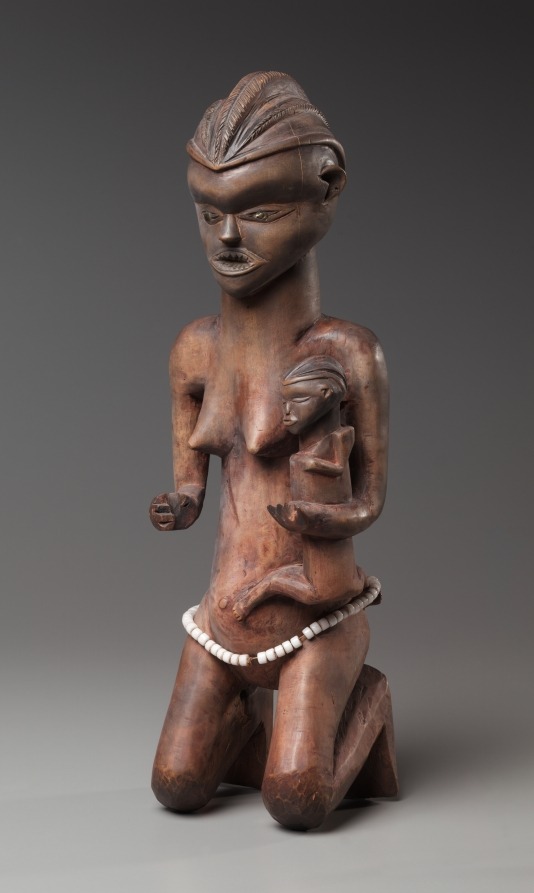
Mother-and-Child Figure, late 1800s-early 1900s, Cleveland Museum of Art: African Art
Wearing an elaborate lobed headdress and a beaded waistbelt, and having filed teeth and red-powdered skin, this maternity figure seems to have once carried an ax and a cup, wooden imitations of the two most important chiefly attributes. Perhaps together with a male counterpart, it was secretly kept inside the ritual house, serving as a guardian of the chief’s treasure. Its style places it in the westernmost corner of Pendeland, between the Lutshima and Kwilu rivers.
Size: Overall: 53.4 x 13.1 x 14.6 cm (21 x 5 3/16 x 5 3/4 in.)
Medium: wood, metal, beads
https://clevelandart.org/art/1931.426
26 notes
·
View notes
Photo
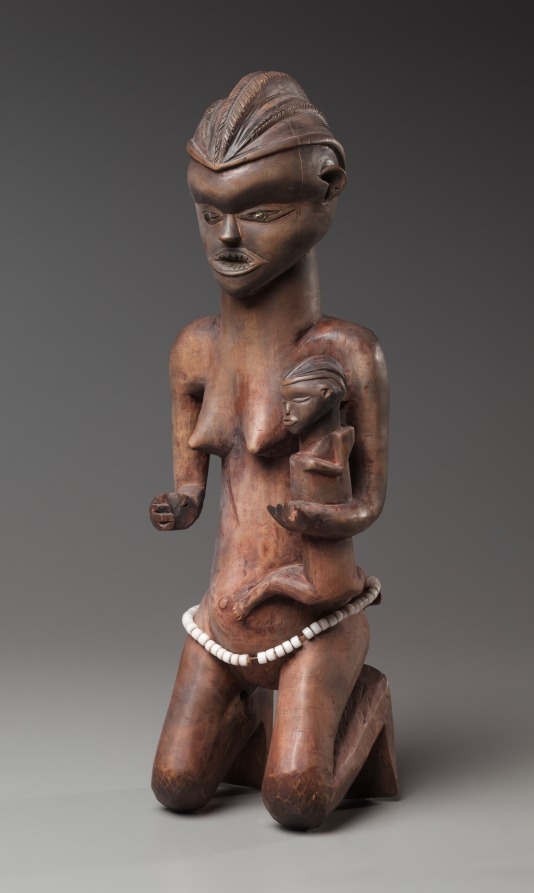
Mother-and-Child Figure, late 1800s-early 1900s, Cleveland Museum of Art: African Art
Wearing an elaborate lobed headdress and a beaded waistbelt, and having filed teeth and red-powdered skin, this maternity figure seems to have once carried an ax and a cup, wooden imitations of the two most important chiefly attributes. Perhaps together with a male counterpart, it was secretly kept inside the ritual house, serving as a guardian of the chief’s treasure. Its style places it in the westernmost corner of Pendeland, between the Lutshima and Kwilu rivers.
Size: Overall: 53.4 x 13.1 x 14.6 cm (21 x 5 3/16 x 5 3/4 in.)
Medium: wood, metal, beads
https://clevelandart.org/art/1931.426
11 notes
·
View notes
Photo

Woman's Skirt, 1875-1925, Cleveland Museum of Art: African Art
This female skirt or hip wrapper is the most extravagant textile of the Mbuun people of the Kwilu-Kwango River Basin. Its overall tan surface is from raffia fiber. It also features elegant geometric surface decoration called lobubasa: the diamond-shaped patterns embroidered on the upper and lower part of the textile with dyed fiber and through the center where the panels that form the textile converge. As a prestige cloth it most likely was only worn on special occasions such as burials or for ceremonial functions. Although it is a women's cloth, it is woven by men, a norm shared by neighboring cultures such as the Kuba and the Kongo, which have similarly rich textile traditions.
Size: Overall: 73.7 x 102.9 cm (29 x 40 1/2 in.)
Medium: Raffia palm fiber
https://clevelandart.org/art/2013.5
11 notes
·
View notes
Photo

Mother-and-Child Figure, late 1800s-early 1900s, Cleveland Museum of Art: African Art
Wearing an elaborate lobed headdress and a beaded waistbelt, and having filed teeth and red-powdered skin, this maternity figure seems to have once carried an ax and a cup, wooden imitations of the two most important chiefly attributes. Perhaps together with a male counterpart, it was secretly kept inside the ritual house, serving as a guardian of the chief’s treasure. Its style places it in the westernmost corner of Pendeland, between the Lutshima and Kwilu rivers.
Size: Overall: 53.4 x 13.1 x 14.6 cm (21 x 5 3/16 x 5 3/4 in.)
Medium: wood, metal, beads
https://clevelandart.org/art/1931.426
14 notes
·
View notes
Photo
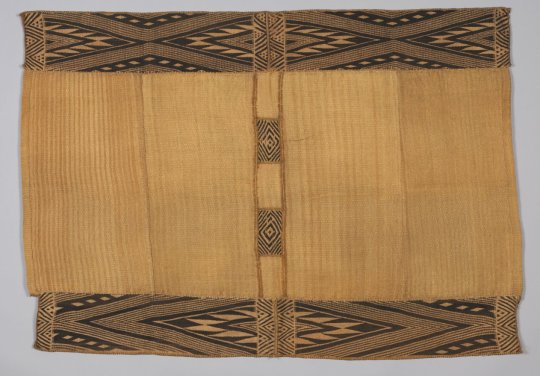
Woman's Skirt, 1875-1925, Cleveland Museum of Art: African Art
This female skirt or hip wrapper is the most extravagant textile of the Mbuun people of the Kwilu-Kwango River Basin. Its overall tan surface is from raffia fiber. It also features elegant geometric surface decoration called lobubasa: the diamond-shaped patterns embroidered on the upper and lower part of the textile with dyed fiber and through the center where the panels that form the textile converge. As a prestige cloth it most likely was only worn on special occasions such as burials or for ceremonial functions. Although it is a women's cloth, it is woven by men, a norm shared by neighboring cultures such as the Kuba and the Kongo, which have similarly rich textile traditions.
Size: Overall: 73.7 x 102.9 cm (29 x 40 1/2 in.)
Medium: Raffia palm fiber
https://clevelandart.org/art/2013.5
38 notes
·
View notes
Photo
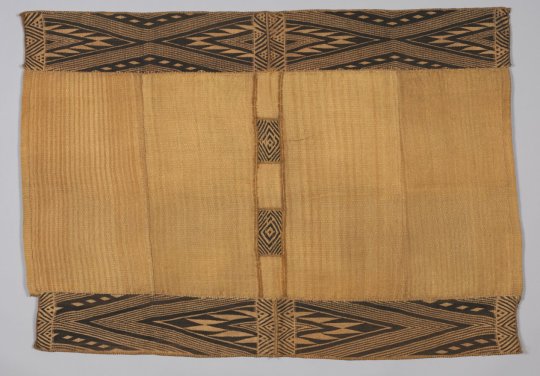
Woman's Skirt, 1875-1925, Cleveland Museum of Art: African Art
This female skirt or hip wrapper is the most extravagant textile of the Mbuun people of the Kwilu-Kwango River Basin. Its overall tan surface is from raffia fiber. It also features elegant geometric surface decoration called lobubasa: the diamond-shaped patterns embroidered on the upper and lower part of the textile with dyed fiber and through the center where the panels that form the textile converge. As a prestige cloth it most likely was only worn on special occasions such as burials or for ceremonial functions. Although it is a women's cloth, it is woven by men, a norm shared by neighboring cultures such as the Kuba and the Kongo, which have similarly rich textile traditions.
Size: Overall: 73.7 x 102.9 cm (29 x 40 1/2 in.)
Medium: Raffia palm fiber
https://clevelandart.org/art/2013.5
6 notes
·
View notes
Photo
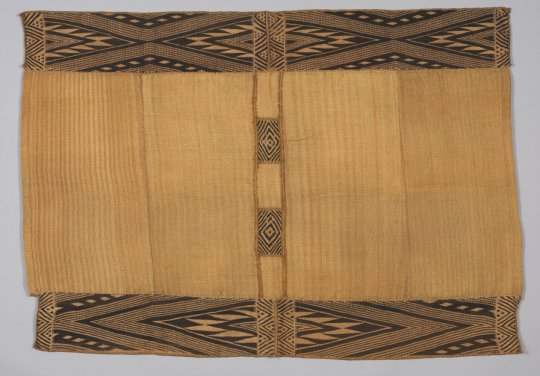
Woman's Skirt, 1875-1925, Cleveland Museum of Art: African Art
This female skirt or hip wrapper is the most extravagant textile of the Mbuun people of the Kwilu-Kwango River Basin. Its overall tan surface is from raffia fiber. It also features elegant geometric surface decoration called lobubasa: the diamond-shaped patterns embroidered on the upper and lower part of the textile with dyed fiber and through the center where the panels that form the textile converge. As a prestige cloth it most likely was only worn on special occasions such as burials or for ceremonial functions. Although it is a women's cloth, it is woven by men, a norm shared by neighboring cultures such as the Kuba and the Kongo, which have similarly rich textile traditions.
Size: Overall: 73.7 x 102.9 cm (29 x 40 1/2 in.)
Medium: Raffia palm fiber
https://clevelandart.org/art/2013.5
8 notes
·
View notes
Photo

Mother-and-Child Figure, late 1800s-early 1900s, Cleveland Museum of Art: African Art
Wearing an elaborate lobed headdress and a beaded waistbelt, and having filed teeth and red-powdered skin, this maternity figure seems to have once carried an ax and a cup, wooden imitations of the two most important chiefly attributes. Perhaps together with a male counterpart, it was secretly kept inside the ritual house, serving as a guardian of the chief’s treasure. Its style places it in the westernmost corner of Pendeland, between the Lutshima and Kwilu rivers.
Size: Overall: 53.4 x 13.1 x 14.6 cm (21 x 5 3/16 x 5 3/4 in.)
Medium: wood, metal, beads
https://clevelandart.org/art/1931.426
10 notes
·
View notes